 A team from the University of Leicester Archaeological Services (ULAS) has unearthed an unprecedented collection of Iron Age metal artifacts at Glenfield Park in Leicestershire. The excavation took place in the winter of 2013/2014 in advance of construction of a large-scale warehouse and distribution center on the site which was known to have had Iron Age remains from a small excavation in the 1990s and occasional discoveries after that by field walkers. What nobody knew was the size, extent and age of the Iron Age occupation.
A team from the University of Leicester Archaeological Services (ULAS) has unearthed an unprecedented collection of Iron Age metal artifacts at Glenfield Park in Leicestershire. The excavation took place in the winter of 2013/2014 in advance of construction of a large-scale warehouse and distribution center on the site which was known to have had Iron Age remains from a small excavation in the 1990s and occasional discoveries after that by field walkers. What nobody knew was the size, extent and age of the Iron Age occupation.
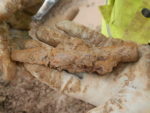 The team focused on a four-hectare area dense with features characteristic of an Iron Age settlement — roundhouses, enclosures, postholes, pits — located at the north end of the development site. The trenches dug by ULAS archaeologists revealed that the full size of the settlement was almost 12 hectares in area and was inhabited throughout the Iron Age and Roman era. The ULAS team also unearthed metalwork, and lots of it: 11 metal cauldrons, either complete or all but, several ring-headed dress pins, an iron involuted brooch, a cast copper alloy horn-cap that may have been part of a ceremonial staff or mace.
The team focused on a four-hectare area dense with features characteristic of an Iron Age settlement — roundhouses, enclosures, postholes, pits — located at the north end of the development site. The trenches dug by ULAS archaeologists revealed that the full size of the settlement was almost 12 hectares in area and was inhabited throughout the Iron Age and Roman era. The ULAS team also unearthed metalwork, and lots of it: 11 metal cauldrons, either complete or all but, several ring-headed dress pins, an iron involuted brooch, a cast copper alloy horn-cap that may have been part of a ceremonial staff or mace.
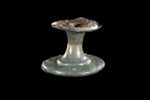
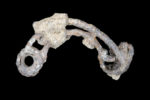
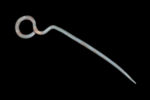
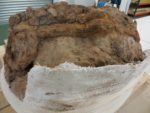 The cauldrons are the stand-out discovery. It is the only second multiple cauldron Iron Age find in Europe, the farthest north on mainland Britain and unique in the East Midlands area. The combination of metalwork is entirely unique; nothing of this range and variety has been found before.
The cauldrons are the stand-out discovery. It is the only second multiple cauldron Iron Age find in Europe, the farthest north on mainland Britain and unique in the East Midlands area. The combination of metalwork is entirely unique; nothing of this range and variety has been found before.
Most of the cauldrons appear to have been deliberately laid in a large circular enclosure ditch that surrounded a building. They had been placed in either upright or inverted positions, before the ditch was filled in, suggesting that they were buried to mark the cessation of activities associated with this part of the site. Other cauldrons were found buried across the site, suggesting that significant events were being marked over a long period of time as the settlement developed.
The cauldrons are made from several separate parts, comprising iron rims and upper bands, hemispherical copper alloy bowls and two iron ring handles attached to the upper band.
They appear to have been a variety of sizes, with rims ranging between 360mm and 560mm in diameter, with the total capacity of all cauldrons being approximately 550 litres, which illustrates their potential to provide for large groups of people that may have gathered at the settlement from the wider Iron Age community of the area.
John [Thomas, director of the excavation and ULAS Project Officer] said: “Due to their large capacity it is thought that Iron Age cauldrons were reserved for special occasions and would have been important social objects, forming the centrepiece of major feasts, perhaps in association with large gatherings and events.
“The importance of cauldrons as symbolic objects is reflected in their frequent appearance in early medieval Irish and Welsh literature, which has been drawn upon in studies of Iron Age society. They are rarely found in large numbers and, with the exception of a discovery in Chiseldon, where 17 cauldrons were found in a pit, there have been few excavated examples in recent years.”
Ritual depositions of objects used for ceremonial banquets appears to have been a common practice in Iron Age Britain and Europe, and the cauldrons would have been very important, very expensive, essential parts of the feast preparations which made them worthy candidates for deposition after the feasting was over.
 Because they were in such fragile condition, the cauldrons were not fully excavated in situ, but raised en bloc still encased in the soil in which they’d lain for thousands of years. Before the painstaking excavation of the soil blocks in laboratory conditions could begin, the cauldrons were sent to the hospital, Paul Strickland Scanner Centre in Middlesex, which had CT scanners large enough to fit the massive metal-stuffed soil blocks.
Because they were in such fragile condition, the cauldrons were not fully excavated in situ, but raised en bloc still encased in the soil in which they’d lain for thousands of years. Before the painstaking excavation of the soil blocks in laboratory conditions could begin, the cauldrons were sent to the hospital, Paul Strickland Scanner Centre in Middlesex, which had CT scanners large enough to fit the massive metal-stuffed soil blocks.
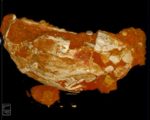 The scans gave archaeologists a roadmap to follow when excavating — the orientation of the cauldrons, their sizes, fragment placement — and a glimpse at even more exciting possibilities, namely evidence of decoration, something that is very rare on metalwork from this period. One of the complete cauldrons has a raised stem and leaf decoration on the iron band near the handle, a motif that is reminiscent of the “Vegetal Style” of Celtic art from around the 4th century B.C. One of the smaller copper alloy bowls appears to have a domed rivet or raised boss decoration.
The scans gave archaeologists a roadmap to follow when excavating — the orientation of the cauldrons, their sizes, fragment placement — and a glimpse at even more exciting possibilities, namely evidence of decoration, something that is very rare on metalwork from this period. One of the complete cauldrons has a raised stem and leaf decoration on the iron band near the handle, a motif that is reminiscent of the “Vegetal Style” of Celtic art from around the 4th century B.C. One of the smaller copper alloy bowls appears to have a domed rivet or raised boss decoration.
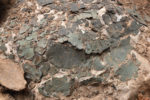 Conservation and excavation of the cauldrons will be taking place at the Museum of London Archaeology (MOLA), and things are already looking promising.
Conservation and excavation of the cauldrons will be taking place at the Museum of London Archaeology (MOLA), and things are already looking promising.
Liz Barham, Senior Conservator at MOLA said: “Already we have been able to uncover glimpses of the detailed histories of these cauldrons through CT scanning, including evidence of their manufacture and repair, and have identified sooty residues still clinging to the base of one of the cauldrons from the last time it was suspended over a fire. During the upcoming conservation we hope to discover much more about the entire assemblage. If we’re lucky, we may even find food residues from the last time they were used – over 2000 years ago.”
This video gives a brief overview of the site and the discoveries, including clips of the first cauldron’s CT scan.
This one focuses on the CT scans of the cauldrons: